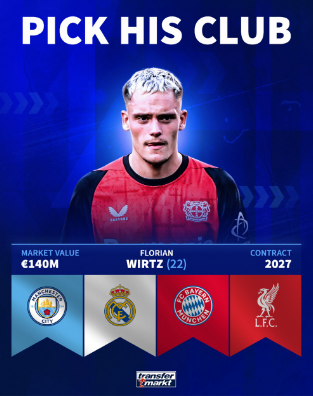Current Trends in the Transfer Market
The transfer market has undergone significant transformations recently, particularly as we move through October 2023. Financial Fair Play (FFP) regulations have played a crucial role in shaping the strategies of clubs, prompting them to operate within their financial means while still striving to improve their squads. Many teams have recognized that the old method of acquiring star players at exorbitant prices is no longer sustainable. Instead, clubs are turning their attention to younger talents who possess the potential for growth and development, posing a strategic shift in the overall approach to recruitment.
One of the most evident trends is the rise of players like Victor Osimhen and Christopher Nkunku, who have emerged as sought-after commodities in this evolving landscape. Rather than solely signing seasoned professionals, clubs are investing in these promising individuals, reflecting a broader acceptance of a long-term vision. The impressive performances of younger talents like Liam Delap further emphasize the growing value placed on developing homegrown players or standout youngsters from other clubs. This shift highlights a significant change in mindset where clubs prioritize adaptation over immediate gratification.
The recent transfer windows have seen a decrease in fear-driven acquisitions of established stars, with clubs increasingly relying on thorough scouting networks to discover emerging talents. This not only allows clubs to secure profitable investments but also fosters a competitive environment wherein these younger players can mature into pivotal squad members. As teams navigate this transitional period, it is apparent that monitoring and nurturing young prospects will be integral to achieving success in the future. The ongoing influence of FFP regulations, coupled with an emphasis on cultivating talent, will likely continue to dominate conversations surrounding transfer rumors and market activities for the foreseeable future.
Key Players to Watch: Who’s on the Move?
As the transfer window approaches, attention turns toward a handful of high-profile footballers whose potential moves could significantly impact their clubs and leagues. Among these key players is Victor Osimhen, the Nigerian striker whose impressive goal-scoring record at Napoli has caught the eye of several European giants. His remarkable pace and technical ability have not only made him a fan favorite but have also led to reports linking him with transfers to clubs like Manchester United and Chelsea. With a booming market value estimated in the region of €100 million, Osimhen’s move could reshape the attacking options of any club willing to invest in his talents.
Another player generating buzz is Christopher Nkunku, currently with RB Leipzig. The French midfielder has demonstrated tremendous versatility and creativity on the field, making him a prime target during the transfer window. Recent rumors suggest that clubs such as Arsenal and Liverpool are interested in acquiring his services. Nkunku’s ability to contribute both as a playmaker and a goal scorer makes him an appealing option for teams seeking to bolster their midfield dynamics. His consistent performances in the Bundesliga have contributed to a spike in his market value, resulting in heightened speculation around his future.
Additionally, young talent Liam Delap has emerged as a significant prospect. Currently at Manchester City, his impressive performances on loan have opened avenues for potential transfers as clubs recognize the need to invest in new attacking talent. Delap’s ability to adapt quickly and perform under pressure has led to considerations from various clubs looking to strengthen their squads ahead of the upcoming season. As transfer rumors swirl, identifying these players and understanding the implications of their potential transfers will be crucial for fans and analysts alike.
Impact of Transfer Deals on Clubs and Fans
The transfer window is a pivotal period in the football calendar, often determining the fortunes of clubs and influencing the emotions of their supporters. Transfers are not merely about exchanging players; they represent moments that can either uplift or disappoint fanbases. High-profile moves, such as those involving talented players like Victor Osimhen or Christopher Nkunku, can generate immense excitement. These signings often signal a club’s intent to compete at the highest level and can galvanize supporters, leading to increased attendance at matches and greater engagement in club activities.
The impact of significant signings goes beyond mere enthusiasm. Fans tend to respond positively to star players, which results in a boost in merchandise sales. For instance, a prolific striker such as Liam Delap arriving at a club could catalyze merchandise upswing, with fans eager to acquire jerseys and memorabilia showcasing their new favourite player. Moreover, strong transfer rumors often create a buzz, engaging fans through social media platforms, thereby fostering a sense of community. Clubs that strategically manage these rumors can harness this energy to maintain fan interest and loyalty throughout the season.
Conversely, the emotional rollercoaster of the transfer market can lead to frustration and heartbreak. The departure of beloved players often provokes strong reactions from supporters. Losing a key player to a rival club can dampen spirits, leading to public outcry and dissatisfaction. Clubs, recognizing this, must implement long-term strategies to ensure continued engagement with their fanbase during these tumultuous periods. Effective communication through official channels and openness about transfer decisions can help assuage concerns and keep supporters invested in the club’s journey. By navigating the complexities of the transfer market thoughtfully, football clubs can foster enduring relationships with their fans while enhancing their competitive posture on the field.
Future Predictions: What’s Next for the Transfer Market?
The transfer market is poised for several transformations as clubs adapt to changing economic landscapes and innovative recruitment strategies. One of the key factors influencing this evolution is the economic impact of recent global events, which may lead to adjustments in transfer fees. Historically, marquee players such as Victor Osimhen and Christopher Nkunku have commanded hefty sums, but financial prudence might dictate a shift towards more sustainable investments in up-and-coming talents, such as Liam Delap. This trend could see clubs exploring value-for-money signings increasingly, reshaping the market dynamics.
Another significant element influencing the future of the transfer market is the growing reliance on data analytics for player recruitment. Clubs are increasingly employing sophisticated metrics to identify hidden gems, thereby enhancing their scouting processes. This analytical approach allows teams to make informed decisions based on performance data rather than merely reputation, which may lead to a more competitive landscape. Consequently, players previously overlooked may emerge as key targets during the transfer window, challenging the established norms of player acquisitions.
The rise of emerging leagues is also expected to play a pivotal role in shaping the transfer market. As clubs from these leagues attract attention and financial backing, they will likely become more influential in the recruitment sphere. Established clubs may need to recalibrate their strategies to compete for talent, impacting transfer rumors and negotiations. Additionally, ongoing discussions surrounding potential regulatory changes could further complicate the market dynamics. Compliance with new rules may encourage clubs to adapt their spending strategies and recruitment methods, influencing how they approach the transfer window going forward. Overall, as clubs navigate these complexities, the transfer market is set for an intriguing evolution in the years ahead.

